The obsession with fencing
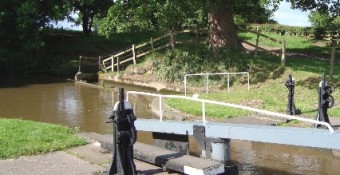 IT WAS Victor Swift who first publicised British Waterways current obsession with erecting fencing, to the detriment of maintenance, with many others now telling of this present wastage of money and resources.
IT WAS Victor Swift who first publicised British Waterways current obsession with erecting fencing, to the detriment of maintenance, with many others now telling of this present wastage of money and resources.
We were out for near two months earlier this year and noted—especially on the Llangollen—BW's fence obsession. Up there every BW man working either had a boat or truck piled with expensive pre-planed wood. None of your rough stuff us poor peasants have to buy, writes Ruth Cragg.
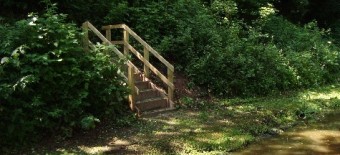 Already over the winter they seemed to have put a lot up as safety fencing, some replacing Defra rash rather than fixing things wrong or dangerous. In one place for example—Swanley Bottom—where the ground behind the lock wall on the towpath side started falling in some years back, they made no effort to fix but first had the rash and now the fence, which also stops any BW or contract foliage removal from the lock side so the foliage is feet long and extends across half the lock entrance.
Already over the winter they seemed to have put a lot up as safety fencing, some replacing Defra rash rather than fixing things wrong or dangerous. In one place for example—Swanley Bottom—where the ground behind the lock wall on the towpath side started falling in some years back, they made no effort to fix but first had the rash and now the fence, which also stops any BW or contract foliage removal from the lock side so the foliage is feet long and extends across half the lock entrance.
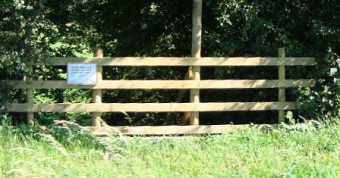 Seeing all the fencing we wondered if the Health & Safety department of BW—after their bollard triumph of last year have (to get their productivity bonus?) come up with safety fencing as the next big cash waster. Who can object to it—every bit is for our safety!
Seeing all the fencing we wondered if the Health & Safety department of BW—after their bollard triumph of last year have (to get their productivity bonus?) come up with safety fencing as the next big cash waster. Who can object to it—every bit is for our safety!
The need to spend money on posh wood for safety does not end with locks and sluices—many of which are also being fenced off for the first time in their history. Along the canal it is noticeable that many sets of steps from bridges to towpath are getting new rails—and some are getting new steps to go with the new rails!
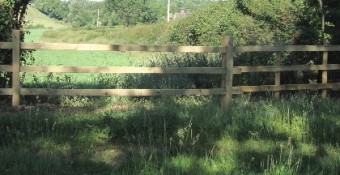 Meanwhile masses of wood are being used, as parts of the towpath itself are being fenced off from the adjacent land, even where there is already a farmers' fence in many places. And some of these fences—near bridges have flash looking gates which might be unlocked to get plant onto the towpath—one wonders to do what.
Meanwhile masses of wood are being used, as parts of the towpath itself are being fenced off from the adjacent land, even where there is already a farmers' fence in many places. And some of these fences—near bridges have flash looking gates which might be unlocked to get plant onto the towpath—one wonders to do what.
In other places the fences prevent access at some bridges. One assumes BW is working to an in-house plan to use wood for? Who knows.
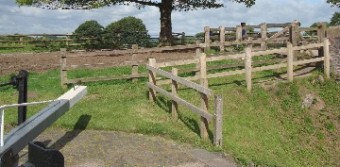 Meanwhile, with so much cash going on wood works, large chunks of towpath have 6ft weeds and even the walking bit needs to be cut back from a foot or more. Those fenced side sluices continue to re-enter the canals (moving their 11 million gallons of money for BW water down the Llangollen) at such angles and position to throw boats about and damage banks and crashing into locks. For this BW will not spend a penny on Health & Safety for sluice alignment nor to replace the Armco at many lock and bridge moorings which is downright dangerous as it has edges sticking out at various angles. Then there are at least three bridges that are damaged but un-repaired after some years.
Meanwhile, with so much cash going on wood works, large chunks of towpath have 6ft weeds and even the walking bit needs to be cut back from a foot or more. Those fenced side sluices continue to re-enter the canals (moving their 11 million gallons of money for BW water down the Llangollen) at such angles and position to throw boats about and damage banks and crashing into locks. For this BW will not spend a penny on Health & Safety for sluice alignment nor to replace the Armco at many lock and bridge moorings which is downright dangerous as it has edges sticking out at various angles. Then there are at least three bridges that are damaged but un-repaired after some years.
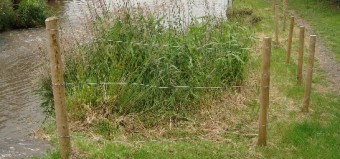 The last example we find appalling. (Pictured here). This hole (or whatever BW call it) appeared behind the lock brickwork at the bottom end of Swanley Bottom Lock a couple of years back.
The last example we find appalling. (Pictured here). This hole (or whatever BW call it) appeared behind the lock brickwork at the bottom end of Swanley Bottom Lock a couple of years back.
BW fenced it off with Defra rash then left it unfixed. As you can see the grass cutters leave the area uncut so it grows out across the lock. When we pass we trim it!
Then last year the rash was replaced by the first noticed example of BW wooden fencing—cheap posts with wire you will note. And that is how it has stayed ever since with BW making no effort to fix the original problem. And, given the grass growing and covering the hole(?) we assume they don't bother to see if it has got worse.
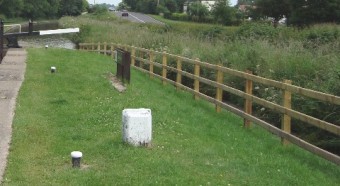 Meanwhile BW do visit the lock, for in went the bollards by the lock. Now this year is the year of wood with the fences and other wooden stuff being put up all along the canal—someone has their priorities very wrong!
Meanwhile BW do visit the lock, for in went the bollards by the lock. Now this year is the year of wood with the fences and other wooden stuff being put up all along the canal—someone has their priorities very wrong!
The picture shows the useless bollards and the fencing that has not been needed for 200 years.
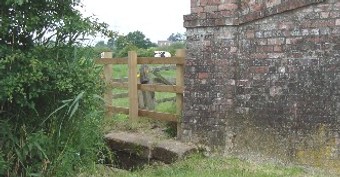 Needless to say if asked about any of these things that should be done and would be of benefit' BW plead poverty, and it has done that when they were previously one of 11 regions and now when one of eight, so I guess the whining will go on when they are back at one of 11.
Needless to say if asked about any of these things that should be done and would be of benefit' BW plead poverty, and it has done that when they were previously one of 11 regions and now when one of eight, so I guess the whining will go on when they are back at one of 11.
With old BW (as in Bureaucratic Waste) nothing really changes.
[The photographs are by the author, Ruth Cragg.]